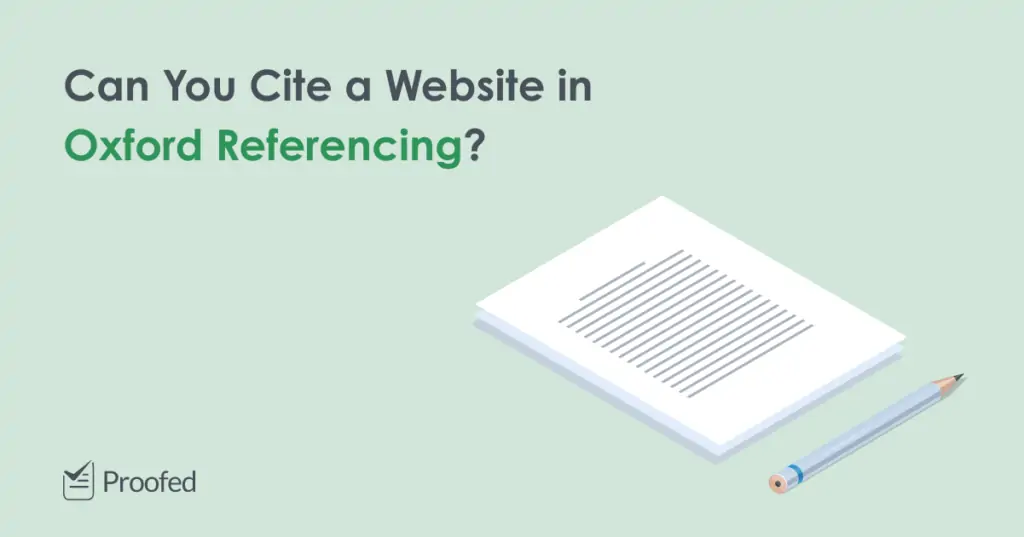With computers now everywhere, it’s common to cite a website or two in academic writing. And to do this with Oxford referencing, you’ll need two things: footnote citations and an entry in a bibliography.
The format for Oxford citations may depend on which version you’re using, so remember to check your style guide if you have one. But if you’re not sure where to start, our guide to referencing a website should help.
Referencing a Website in Footnote Citations
Footnote citations are indicated via superscript numbers in the main text:
This is how a citation should look in your document.1
The first time you reference a website, use the following format:
n. Initial(s). Surname, “Page Title,” Website [website], publication date, section/paragraph number (if applicable), <URL>, accessed date.
You should then end up with something like this:
1. P. Philips, “Going Beyond: How to Reach Mars,” Space Travel [website], 2015, <www.spacetravel.org/mars-travel>, accessed August 2, 2018.
If the website has more than one author, use “and” to separate the final two:
2. A. Moretti and T. Pepe, Mars Remains an Unattainable Dream [website], 2016, <www.spaceexploration.com/aliens>, accessed September 6, 2018.
If the website has four or more authors, use “et al.” after the first name:
3. W. Ellis et al., “Has NASA Finally Outdone Itself?,” The Big Questions [website], 24 June 2014, <www.thebigquestions.org/NASA>, accessed September 4, 2016.
If quoting part of a web page, note the paragraph or section after the date:
Find this useful?
Subscribe to our newsletter and get writing tips from our editors straight to your inbox.
4. T. Harper, “Experiencing Space,” Space from Above [website], 2014, para. 10, <www.spacefromabove.com/experiencing>, accessed September 5, 2018.
Sometimes, you might not be able to find the author or date of publication for a page on a website. If this happens, use the publishing organization in place of the author and/or write “[no date]” in place of the date of publication:
5. Space from Above, “Endless Darkness,” Space from Above [website], [no date], para. 2, <www.spacefromabove.com/void>, accessed September 7, 2018.
As shown above, if the publishing organization is the same as the website, you do not have to repeat this information after the page title.
Subsequent Footnotes
After citing a source once, you can use a shortened footnote format if you cite it again later in the document. One common approach is to give the author’s surname and a relevant paragraph number. Another approach is to use the Latin abbreviations “ibid.,” “op cit.,” and “loc. cit.”:
- Ibid. (meaning “in the same place”) – We use this to cite the same source twice in a row. These are known as consecutive citations. Make sure to include a new page number if you’re citing a different part of the same text.
- Op. cit. (“in the work cited”) – Used for citing a different part of the text in a non-consecutive citation (i.e., when you have cited at another source since the initial footnote). Give this after the author’s surname. If you have cited more than one source by the author, include a shortened source title.
- Loc. cit. (“in the place cited”) – As above, but we use this one when citing the same page as in the initial footnote citation.
If you have one, it is worth checking your university’s style guide to see if it specifies a shortened citation format. But whichever method you use, make sure to apply it consistently in your document.
Adding a Website in an Oxford Bibliography
At the end of your document, you should add all cited sources to a bibliography. The format to use here for a website is as follows:
Surname, Initial(s), “Page Title,” Website Name [website], date of publication, URL, accessed date.
In practice, then, the bibliography entry for a website would look like this:
Philips, P., “Going Beyond: How to Reach Mars,” Space Travel [website], 2015, www.spacetravel.org/mars-travel, (accessed August 2, 2018).
As with footnotes, if a website doesn’t have a named author, use the publishing organization. If there is no date, write “[no date]” to show this.



